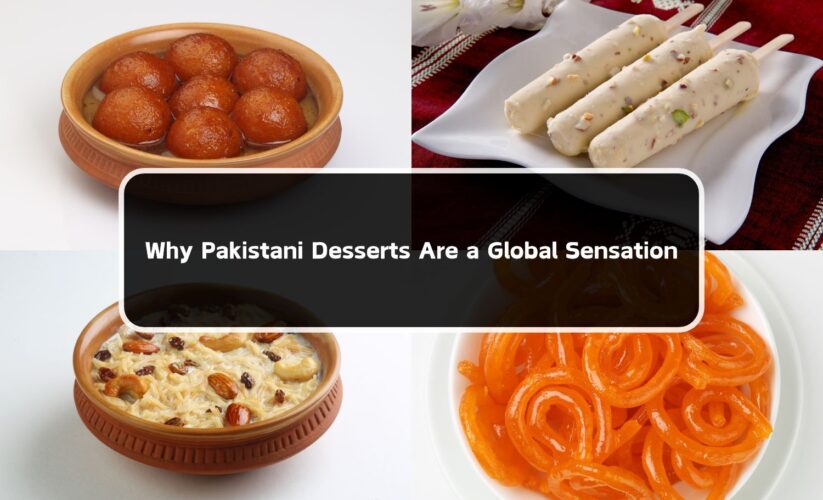
Why Pakistani Desserts Are a Global Sensation
When it comes to desserts, Pakistan has carved a unique place in the world of culinary delights. From the aromatic sweetness of gulab jamun to the creamy richness of kheer, Pakistani desserts are a blend of tradition, culture, and irresistible flavors that captivate taste buds globally. These desserts are more than just sweet treats—they are a celebration of heritage, a showcase of vibrant ingredients, and a true reflection of Pakistan’s diverse culinary landscape. Moreover, indulge in the sweet magic of Pakistani desserts at Chef Cooking Resort—where tradition meets irresistible flavor!
In this article, we’ll explore what makes Pakistani desserts a global sensation, highlighting their unique characteristics, cultural significance, and must-try dishes that have won hearts across borders.
1. The Cultural Significance of Pakistani Desserts
In Pakistan, desserts are not merely an afterthought at the dining table. They hold cultural, religious, and emotional significance. Sweets are an essential part of celebrations, festivals, weddings, and even moments of everyday joy.
A Symbol of Celebration
Desserts like gulab jamun and jalebi are staples at weddings and family gatherings, symbolizing happiness and prosperity. During religious festivals like Eid, desserts such as sheer khurma (vermicelli pudding) and seviyan (sweet vermicelli) are lovingly prepared to mark the occasion.
Heritage on a Plate
Pakistani desserts embody centuries of culinary evolution influenced by Mughal, Persian, and Indian traditions. The use of rich ingredients like saffron, cardamom, and rose water traces back to these historical roots, giving each dessert an authentic and luxurious touch.
2. Unique Ingredients That Define Pakistani Desserts
The distinct flavors of Pakistani desserts are derived from a harmonious blend of locally sourced and traditional ingredients. These ingredients not only enhance taste but also create a sensory experience.
a. Ghee (Clarified Butter)
A cornerstone of Pakistani desserts, ghee imparts a rich and aromatic flavor to sweets like halwa and barfi. Its nutty undertones elevate the texture and taste.
b. Dry Fruits and Nuts
Almonds, pistachios, and cashews are frequently used to garnish or enrich desserts like rabri and kulfi. These nuts add crunch and a touch of luxury.
c. Saffron and Cardamom
These spices are essential for creating the signature aroma of Pakistani sweets. Whether it’s the delicate saffron threads in zarda (sweet rice) or the cardamom pods in kheer, these ingredients add depth and warmth.
3. Popular Pakistani Desserts That the World Loves
a. Gulab Jamun
Arguably the most popular Pakistani dessert globally, gulab jamun consists of deep-fried milk dough balls soaked in sugar syrup infused with cardamom and rose water.
Why It’s a Sensation:
- The melt-in-your-mouth texture paired with the fragrant syrup makes it irresistible.
- Its simple preparation and divine taste have made it a favorite across borders.
b. Kheer
A creamy rice pudding made with milk, sugar, and rice, kheer is often garnished with saffron, nuts, and silver foil.
Why It’s a Sensation:
- Its versatility allows for various adaptations, appealing to a wide audience.
- The rich, comforting flavor makes it a dessert for all occasions.
c. Jalebi
These golden, spiral-shaped sweets are fried to crispy perfection and then soaked in sugar syrup.
Why It’s a Sensation:
- The crispy exterior combined with the syrupy sweetness creates a delightful contrast.
- It’s a popular street food, making it accessible and loved globally.
d. Barfi
A fudge-like dessert made with milk solids, sugar, and flavors like coconut or pistachio, barfi is a celebration essential.
Why It’s a Sensation:
- Its wide variety of flavors caters to different tastes.
- The compact, bite-sized pieces make it easy to serve and enjoy.
e. Kulfi
Often referred to as the South Asian version of ice cream, kulfi is denser and creamier than its Western counterpart. It’s infused with flavors like mango, pistachio, and rose.
Why It’s a Sensation:
- The rich, velvety texture sets it apart from regular ice cream.
- Its exotic flavors make it a unique dessert experience.
4. Global Appeal of Pakistani Desserts
a. A Fusion of Tradition and Modernity
Pakistani desserts have found a place on international menus, often fused with modern culinary techniques. For instance, gulab jamun cheesecake and kheer panna cotta are contemporary takes that bring traditional flavors to new audiences.
b. Accessible Ingredients and Recipes
The simplicity of many Pakistani dessert recipes makes them easy to recreate, even for those unfamiliar with South Asian cuisine. Ingredients like milk, sugar, and rice are universally available, making these desserts approachable worldwide.
c. Globalization of Pakistani Cuisine
As Pakistani restaurants and food festivals gain traction in cities like London, New York, and Dubai, desserts play a key role in showcasing the country’s culinary prowess. Social media platforms have also amplified their appeal, with food bloggers and chefs sharing recipes and reviews.
5. Health Benefits of Pakistani Desserts
While indulgent, many Pakistani desserts offer surprising health benefits:
a. Nutrient-Rich Ingredients
Desserts like halwa and kheer often include dry fruits, nuts, and milk, providing essential vitamins, minerals, and healthy fats.
b. Natural Sweeteners
Traditional recipes frequently use jaggery or honey as natural sweeteners, offering a healthier alternative to refined sugar.
c. Spice Power
The use of spices like cardamom and cinnamon not only enhances flavor but also aids digestion and boosts metabolism.
6. The Role of Pakistani Desserts in Social Gatherings
In Pakistan, desserts are a symbol of hospitality and love. No meal is considered complete without something sweet, and guests are always served a dessert as a gesture of warmth and generosity. Whether it’s a box of mithai (assorted sweets) gifted during Eid or a platter of jalebi shared at a wedding, desserts strengthen bonds and create lasting memories.
7. Must-Try Regional Specialties
Each region in Pakistan has its own signature desserts that reflect local flavors and traditions:
a. Sindhi Sweets
The province of Sindh is known for its ladoo and pallo maachh halwa.
b. Punjabi Favorites
Punjab is famous for its gajrela (carrot pudding) and punjiri, a winter dessert made with wheat, ghee, and nuts.
c. Baluchi Delights
In Balochistan, khajoor ka halwa (date halwa) is a local favorite, showcasing the region’s love for dates.
d. Northern Treats
In the northern areas, desserts like balti sweet bread and apricot compote highlight the natural flavors of the region.
8. How to Experience Pakistani Desserts
a. Authentic Pakistani Restaurants
Visit authentic Pakistani restaurants to savor traditional desserts in their true form.
b. Street Food Adventures
Street vendors in cities like Lahore, Karachi, and Peshawar offer some of the most authentic and flavorful sweet treats.
c. Homemade Creations
Thanks to online recipes and tutorials, it’s now easier than ever to recreate these desserts at home.
9. The Future of Pakistani Desserts
The global appreciation for Pakistani desserts continues to grow, fueled by:
- The rise of Pakistani chefs and food bloggers sharing authentic recipes.
- Innovative fusions that combine traditional flavors with modern culinary trends.
- Increased availability of Pakistani ingredients in international markets.
Conclusion
Pakistani desserts are more than just food—they’re a testament to the country’s rich history, diverse culture, and unparalleled culinary artistry. Their unique flavors, deeply rooted traditions, and global adaptability make them a true sensation.
Whether you’re enjoying a piping hot gulab jamun on a cold winter night or indulging in the creamy decadence of kheer, Pakistani desserts promise a journey of flavors that leave an unforgettable mark. So, if you haven’t yet explored the world of Pakistani sweets, it’s time to treat your taste buds to a symphony of sweetness that’s nothing short of extraordinary!
Also, spice up your reading with Chef Cooking Resort Blogs—your gateway to flavors, recipes, and culinary adventures!





